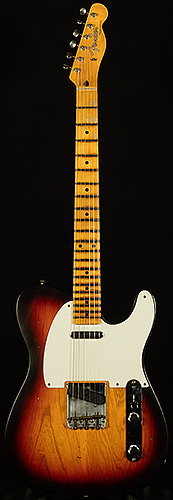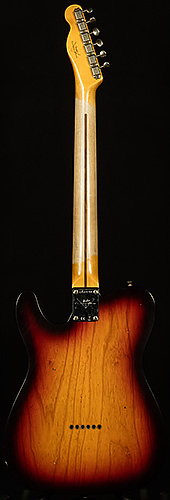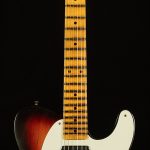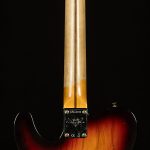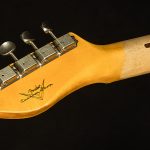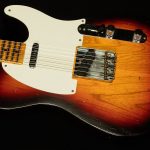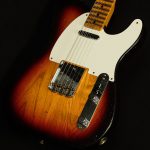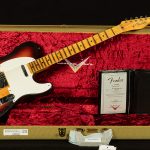Forget the automobile, the fighter jet, and Cheez Whiz: the Fender Telecaster is the greatest invention of the last two centuries. That might sound hyperbolic, but it’s really quite a reasonable thing to say. Every other great invention in the modern era has changed drastically after its initial birth. Model Ts share only four wheels and a steering wheel in common with modern Fords, and modern planes look like alien technology compared to the Wright Brothers’ original contraption (and anyway, you can’t play the blues on a fighter jet, so who cares, anyway?).
By contrast, the modern Telecaster is almost exactly the same as the first prototype Leo Fender ever built in 1950. More impressively, this guitar—which was originally built to cater to the tastes of Western swing guitarists before Read More...
Forget the automobile, the fighter jet, and Cheez Whiz: the Fender Telecaster is the greatest invention of the last two centuries. That might sound hyperbolic, but it’s really quite a reasonable thing to say. Every other great invention in the modern era has changed drastically after its initial birth. Model Ts share only four wheels and a steering wheel in common with modern Fords, and modern planes look like alien technology compared to the Wright Brothers’ original contraption (and anyway, you can’t play the blues on a fighter jet, so who cares, anyway?).
By contrast, the modern Telecaster is almost exactly the same as the first prototype Leo Fender ever built in 1950. More impressively, this guitar—which was originally built to cater to the tastes of Western swing guitarists before rock and roll was even a twinkle in Chuck Berry’s eye—found devotees in every musical genre under the sun. What’s the secret behind the wide-ranging, lasting appeal of the original design? Well, frankly, the answer is simple: the Telecaster is a perfect instrument, and you can’t improve on perfection.
Of course, hindsight is always 20/20, and the Telecaster wasn’t even close to a sure thing when it debuted. In fact, when Fred Gretsch first laid eyes on the Tele he said “that thing will never sell.” When it was unveiled, players scoffed and called it a “boat paddle” and a “snow shovel.” We can forgive these pessimistic pickers for their skepticism; after all, in 1950, solid-body guitars were considered a novelty. Sure, Les Paul had his Log, and Merle Travis had his Bigsby solid-body, but there had never been a production-model solid-body guitar before. Hollow- and semi-hollowbodies ruled the guitar world, and it seemed ridiculous to imagine anything supplanting them.
Of course, history would vindicate Leo. In the eight or so decades since the Telecaster’s invention, it has been responsible for some of the most magical musical moments of all time. The solo on “Stairway to Heaven,” the crashing chords that open The Clash’s “Should I Stay or Should I Go,” and the sweet fingerpicking on Jeff Buckley’s transcendent version of “Hallelujah” all sprang from the fretboard of a Fender Telecaster. Everyone from heady punk rockers like D Boon to avant-jazz cats like Bill Frisell to soul sidemen like Steve Cropper to otherworldly virtuosos like Danny Gatton all adopted the Telecaster as their instrument of choice.
So, what is the source of the Telecaster’s universal appeal across genres and its incredible staying power? What makes it so perfect? Two words: elegant simplicity. The Telecaster is an incredibly simple guitar. It’s a plank of wood with a bolt-on neck, two pickups, two knobs, one switch, a bridge, and six tuners. It’s a completely unpretentious workhorse that cuts a striking figure with its iconic rounded cutaway, clean lines, and curvy shape.
Yet despite its simplicity, it’s one of the most versatile guitars on the planet. You can’t cop a million sounds on a Telecaster, but the ones you can dial in work in just about any musical context. The bridge pickup usually has punchy midrange, cutting highs, and thumping bass, while the neck pickup has broader midrange response, smoother highs, and woodier, warmer bass response. The middle position is a balanced, full-sounding blend of the two. So, Telecaster players have an ideal bright, aggressive sound, a delightfully warm, mellow sound, and a pleasant middle ground between the two at their disposal at all times! When you get down to brass tacks, that’s all you really need as a guitar player. With one three-way selector switch, you can get the right tones for just about any live gig or recording session, and look good doing it!
We’re proud to showcase our selection of Telecasters for our exceptional customers, and we invite you to gaze at the cornucopia of beautiful guitars on this page. After a couple minutes of ogling, we think you’ll agree: eight decades after its birth in Leo Fender’s shop, the Telecaster is still the picture of perfection.
[collapse]


